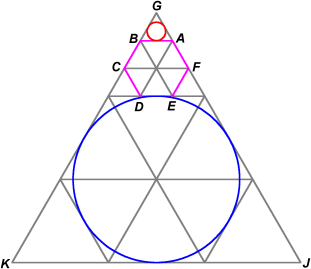Difference between revisions of "2010 AMC 10B Problems/Problem 20"
Mathgeek2006 (talk | contribs) m (→Problem) |
Riflescoop (talk | contribs) m (→Solution 1) |
||
| Line 6: | Line 6: | ||
== Solution 1 == | == Solution 1 == | ||
| − | A good diagram is very helpful. | + | A good diagram is very helpful. Also, BC and FA are LINES, not LINE SEGMENTS. |
<center> [[File:Amc10B 2010.gif]] </center> | <center> [[File:Amc10B 2010.gif]] </center> | ||
Revision as of 13:28, 8 March 2018
Contents
Problem
Two circles lie outside regular hexagon ![]() . The first is tangent to
. The first is tangent to ![]() , and the second is tangent to
, and the second is tangent to ![]() . Both are tangent to lines
. Both are tangent to lines ![]() and
and ![]() . What is the ratio of the area of the second circle to that of the first circle?
. What is the ratio of the area of the second circle to that of the first circle?
![]()
Solution 1
A good diagram is very helpful. Also, BC and FA are LINES, not LINE SEGMENTS.

The first circle is in red, the second in blue.
With this diagram, we can see that the first circle is inscribed in equilateral triangle ![]() while the second circle is inscribed in
while the second circle is inscribed in ![]() .
From this, it's evident that the ratio of the blue area to the red area is equal to the ratio of the areas
.
From this, it's evident that the ratio of the blue area to the red area is equal to the ratio of the areas ![]() to
to ![]()
Since the ratio of areas is equal to the square of the ratio of lengths, we know our final answer is ![]() .
From the diagram, we can see that this is
.
From the diagram, we can see that this is ![]()
Solution 2
As above, we note that the first circle is inscribed in an equilateral triangle of sidelength 1 (if we assume, WLOG, that the regular hexagon has sidelength 1). The inradius of an equilateral triangle with sidelength 1 is equal to ![]() . Therefore, the area of the first circle is
. Therefore, the area of the first circle is ![]() .
.
Call the center of the second circle ![]() . Now we drop a perpendicular from
. Now we drop a perpendicular from ![]() to Circle O's point of tangency with
to Circle O's point of tangency with ![]() and draw another line connecting O to G. Note that because triangle
and draw another line connecting O to G. Note that because triangle ![]() is equilateral,
is equilateral, ![]() .
. ![]() bisects
bisects ![]() , so we have a 30-60-90 triangle.
, so we have a 30-60-90 triangle.
Call the radius of Circle O "![]() ".
".
![]() = height of equilateral triangle + height of regular hexagon + r
= height of equilateral triangle + height of regular hexagon + r
The height of an equilateral triangle of sidelength 1 is ![]() . The height of an equilateral hexagon of sidelength 1 is
. The height of an equilateral hexagon of sidelength 1 is ![]() . Therefore,
. Therefore,
![]() .
.
We can now set up the following equation:
![]()
![]()
![]()
The area of Circle O equals ![]()
Therefore, the ratio of the areas is ![]()
See Also
| 2010 AMC 10B (Problems • Answer Key • Resources) | ||
| Preceded by Problem 19 |
Followed by Problem 21 | |
| 1 • 2 • 3 • 4 • 5 • 6 • 7 • 8 • 9 • 10 • 11 • 12 • 13 • 14 • 15 • 16 • 17 • 18 • 19 • 20 • 21 • 22 • 23 • 24 • 25 | ||
| All AMC 10 Problems and Solutions | ||
The problems on this page are copyrighted by the Mathematical Association of America's American Mathematics Competitions. 









